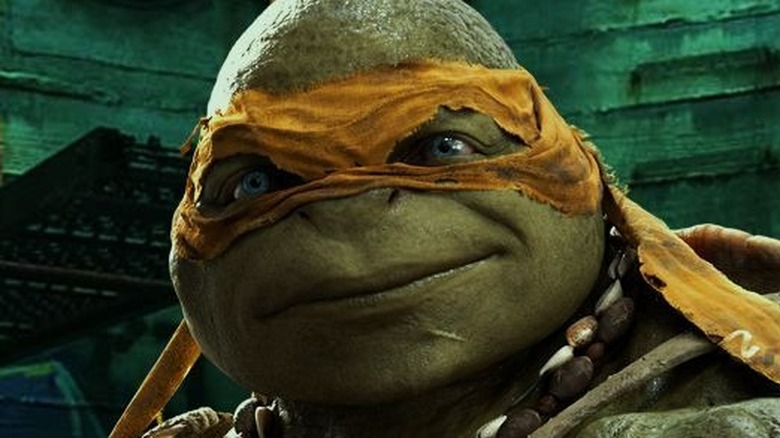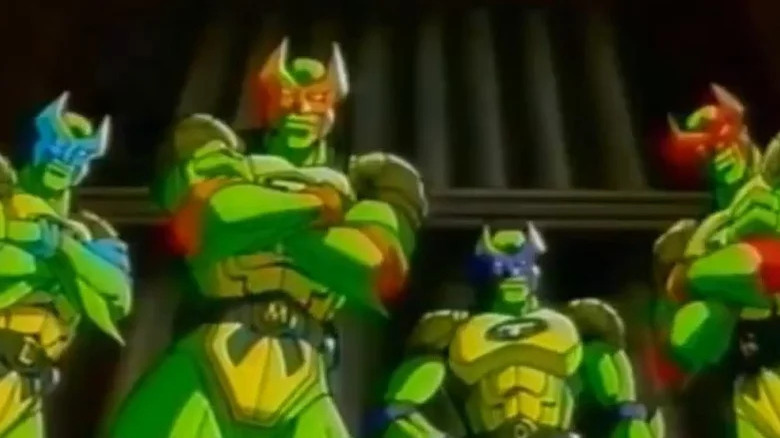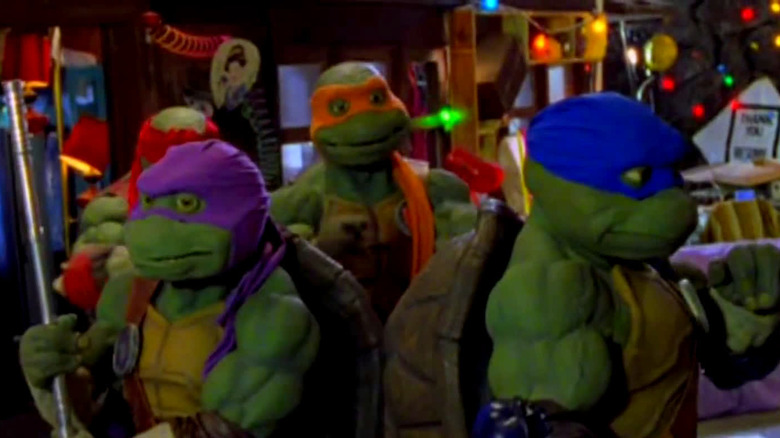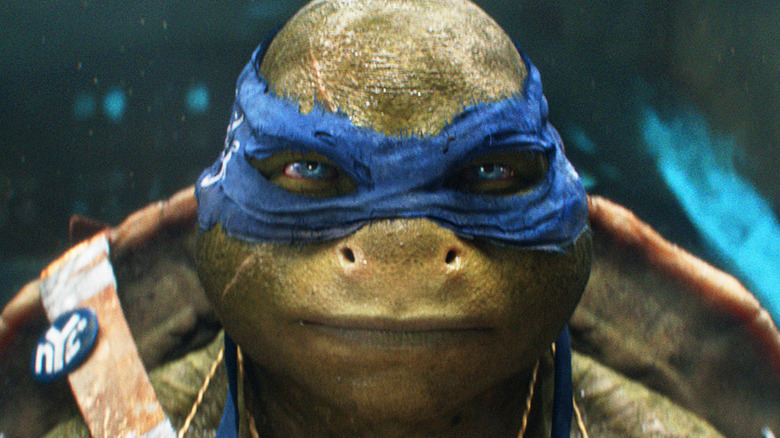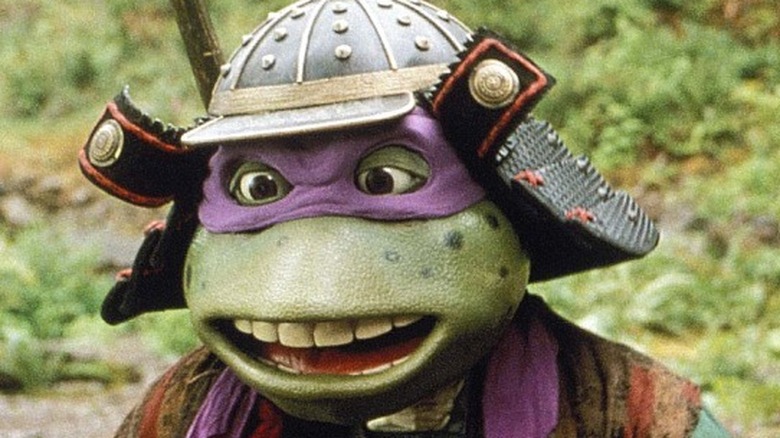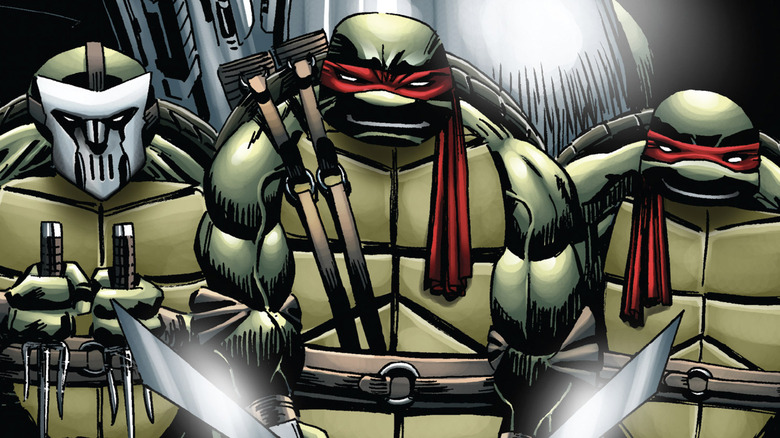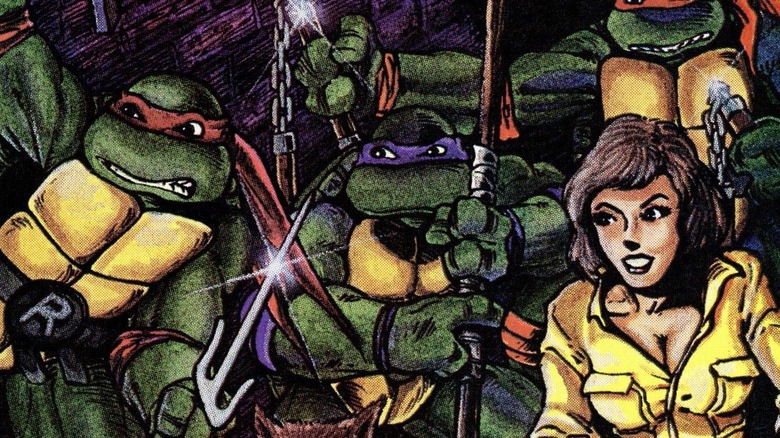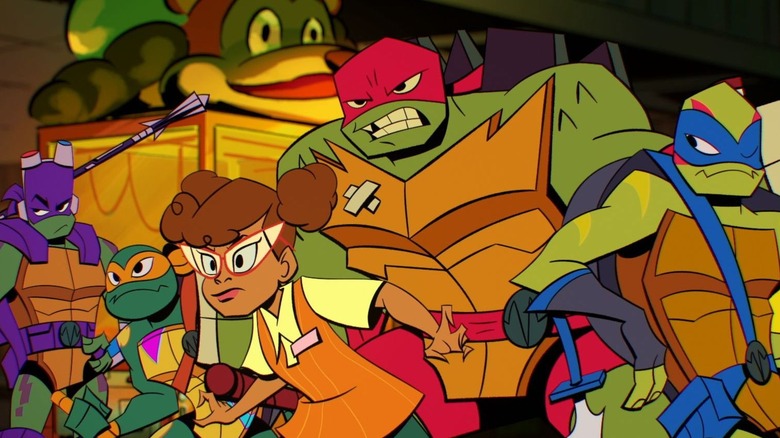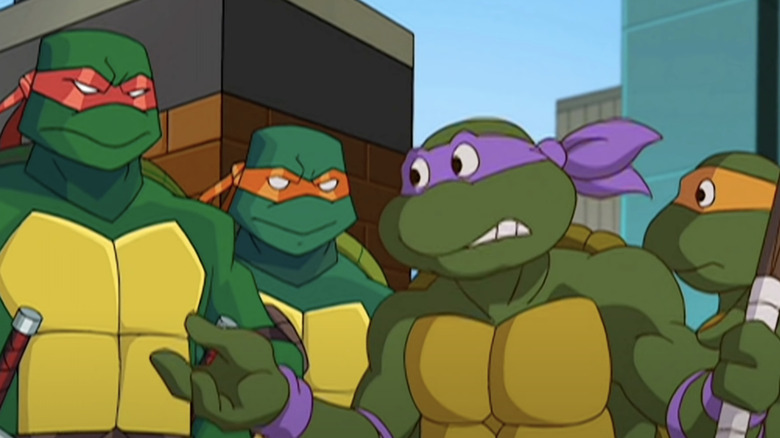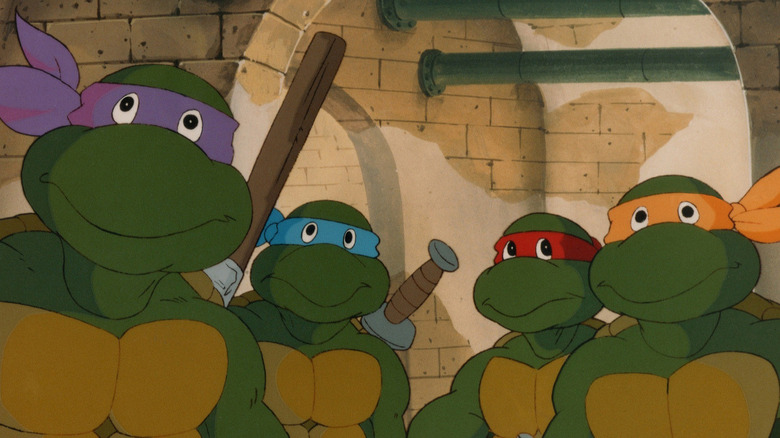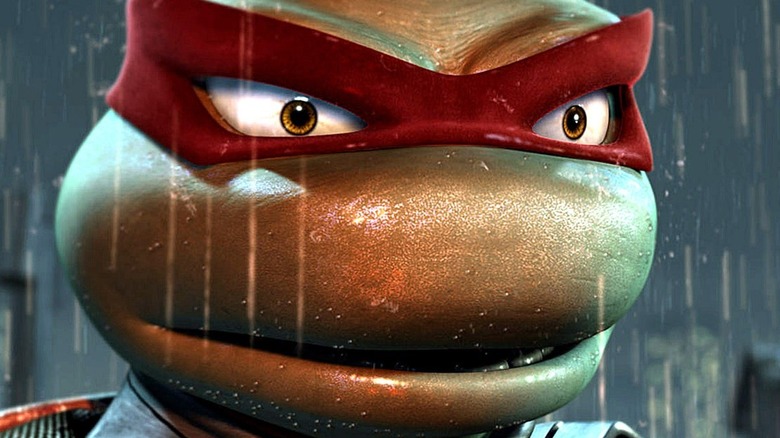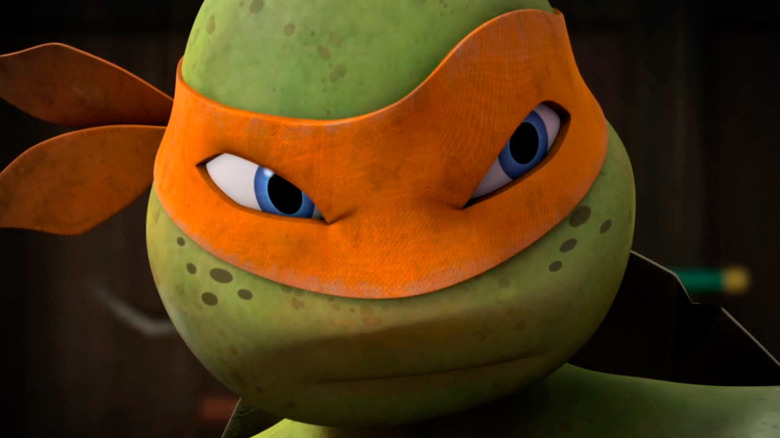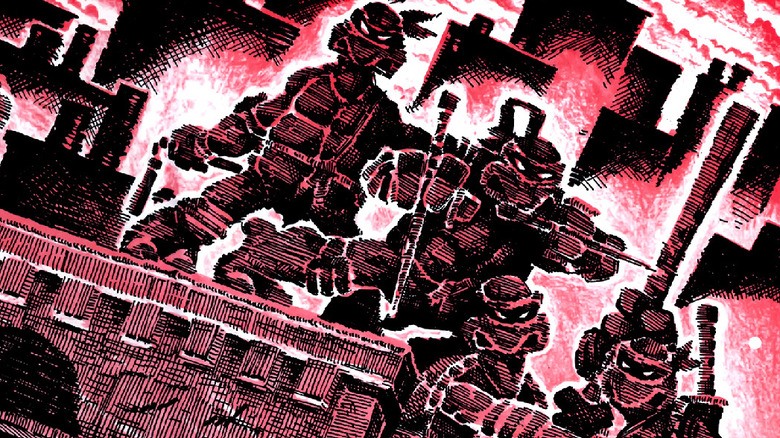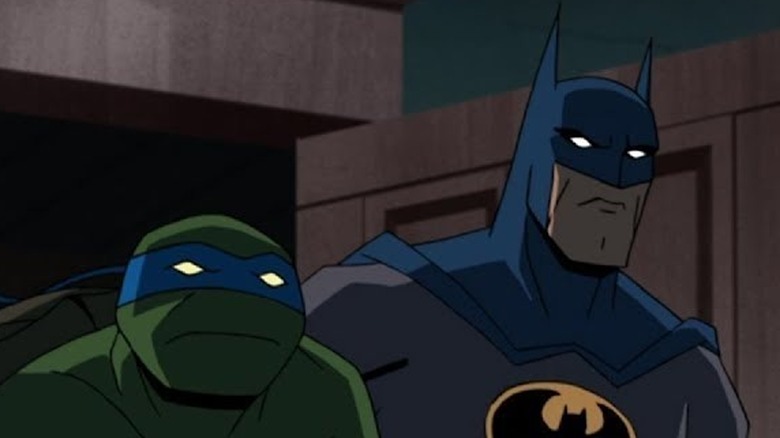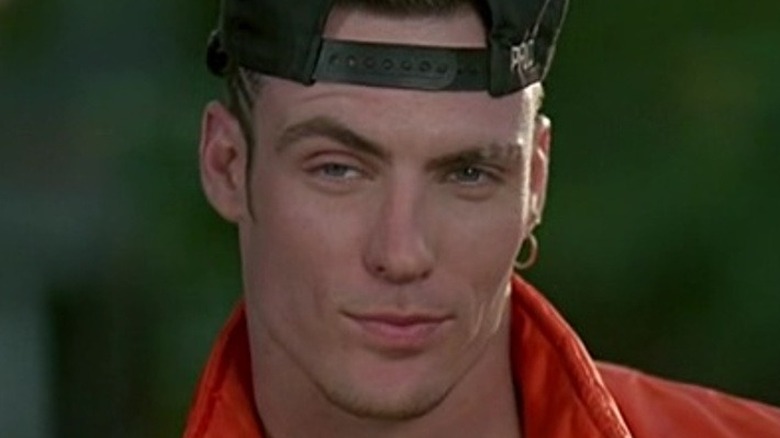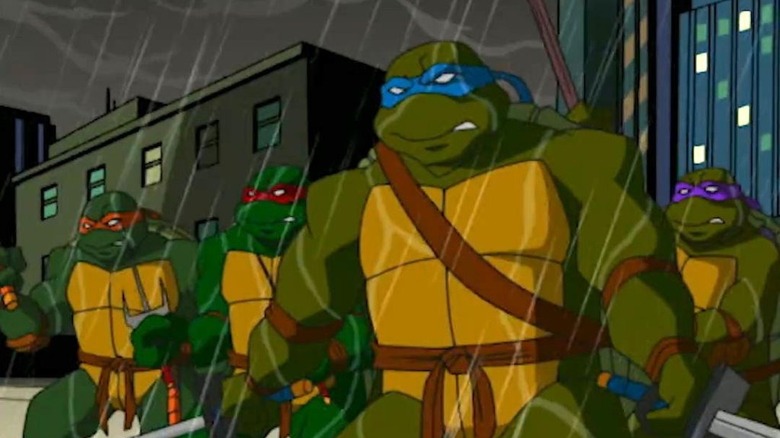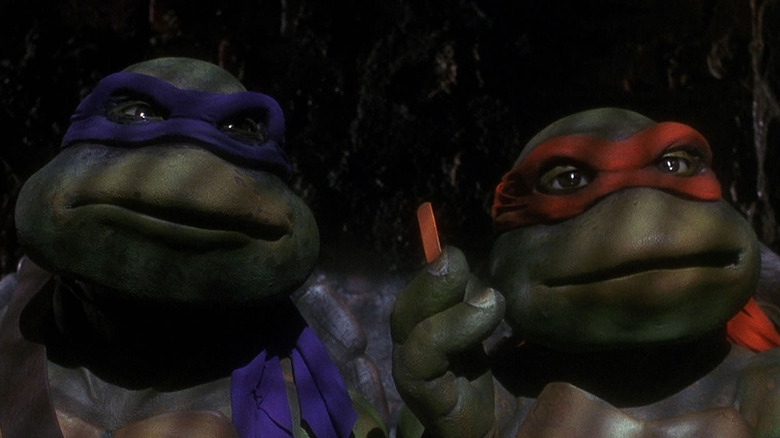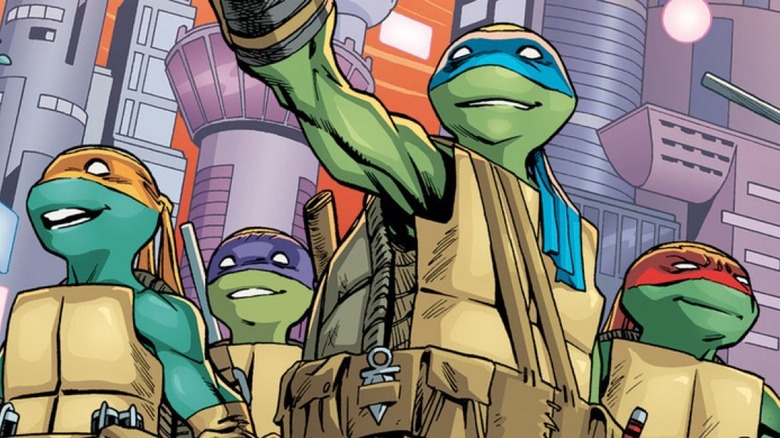Every Incarnation Of The Teenage Mutant Ninja Turtles Ranked From Worst To Best
We may receive a commission on purchases made from links.
It's been almost four radical decades since the world was first introduced to the world's most fearsome fighting team, the heroes in a half shell known as the Teenage Mutant Ninja Turtles. In that time, those turtle boys have gone from cool but rude to party dudes, from leaders to does-machiners, and everywhere in between. They're the only famous foursome who have alternated between dour, gritty ninjas with a singular thirst for vengeance and Vanilla Ice backup dancers, and that's largely because a seemingly endless amount of creative teams have reinvented the Turtles time and time again.
Every few years, the trendy terrapins find themselves rebranded and relaunched, with some aspects of their motley backstories and personalities emphasized and others written out entirely. There are so many versions of the TMNT and all of them vary so wildly that even their corporate owners have officially decreed no version to be "definitive." Instead, the amusing anapsids exist simultaneously in dozens of different forms, each contributing to an overall sense of Ninja Turtle-ness.
While we accept every new comic, television show, and movie as part of the complicated Turtle canon, some adaptations are clearly better than others. With a new cartoon movie, a new CG movie, and a new live-action movie all on the horizon, now is the perfect time to explore the many visions of Turtles past. Here is every incarnation of the Teenage Mutant Ninja Turtles, ranked from worst to best.
17. Honorable mentions
There are many TMNT adaptations that have run long enough to leave their mark on the Turtles' ironically mutable mythology, and they'll make up the bulk of this list. But first, it's worth mentioning the handful of incarnations that never quite found their sea (or sewer) legs and fell overboard soon after launch. Those flashes in the pan were mostly notable for their eccentric, trivia-worthy takes on the turtles and as such, deserve at least a shared honorable mention.
For exactly one day in 1996, there existed a Ninja Turtles anime known as "Mutant Turtles: Superman Legend," and no matter how surreal you expect it to be, expect harder. In the first episode, the brothers gain the ability to transform into armored superheroes with inexplicably human faces. Even more, while in superhero form, the four can merge bodies and souls to become a massive, white "Voltron" robot named the Turtle Saint. It quickly proves handy when they're forced to confront a giant, latex-clad demoness in space.
Then there are the various Ninja Turtles manga series, which actually start as a fairly accurate retelling of the 1987 cartoon series. Soon, however, they begin to take an unwelcome amount of inspiration from the anime series, and once again we reach rock-bottom — a deep, dark domain with a lone sign that reads "Turtle Saint."
16. Ninja Turtles: The Next Mutation
Since they first crawled out of the sewers in 1984, the TMNT have starred in comic after comic, movie after movie, and cartoon after cartoon. Only once, however, have the boys in green managed to score a live-action television show. About three minutes into watching the show, anyone can see why no studio attempted the feat again.
Produced by Saban, the legendary zentai-loving creators of "Power Rangers," the Turtles' one foray into live-action TV was known as "Ninja Turtles: The Next Mutation." Presumably, the mutation in question was an enlargement in every characters' overacting gland. In the majority of their incarnations, the Turtles are geared mainly for children, so some facile dialogue is expected. But "Next Mutation" took that concept and ran with it, eschewing any possible heart in favor of cranking every creative dial up to 11. The sets, props, characters, costumes, and choreography all reek of a director whose only note was "more."
By the end of its one and only season, "Next Mutation" gives fans only a few major facets to celebrate, but they do exist. One is the introduction of Venus de Milo, the first of two female Ninja Turtles. Although TMNT co-creator Peter Laird is outspoken about his hatred for de Milo, she was nonetheless a big step forward for an otherwise male-centric franchise.
15. The Michael Bay reboots
It's no secret that the TMNT reboot movies from 2014 and 2016, heavily impacted by the trademark excessiveness of producer Michael Bay, were not fan favorites. They also failed to win over critics. Even the filming process left some actors "hating life." Although both films were successful financially, they left too many of the parties involved with bad tastes in their mouths and no appetite for thirds.
It's hard to pinpoint exactly how 2014's "Teenage Mutant Ninja Turtles" and 2016's "Teenage Mutant Ninja Turtles: Out of the Shadows" messed up so thoroughly. The most likely explanation is also the simplest — most of the two movies are off balance by just enough to knock the whole experience over. Major issues that fans have pointed to include the hulking, ogre-ish redesign for the titular mutants, the stiff acting behind the human characters, and the first movie's strikingly similar plot to 2012's "The Amazing Spider-Man." But there are other problems to be found wherever you look, be it the forced humor, quantity-over-quality choreography, or whiplash-inducing pacing. Luckily, the first of the two movies allows viewers one shining moment of rest and levity — the unforgettably hilarious elevator beatbox scene.
14. Teenage Mutant Ninja Turtles III
"Teenage Mutant Ninja Turtles III" was the third and last of the original, live-action New Line Cinema TMNT movies. It continued the trend set by "Teenage Mutant Ninja Turtles II: The Secret of the Ooze," in which every successive movie cut out more and more realism and emotion to make room for slapstick comedy. It wasn't necessarily a bad plan for a franchise whose meteoric success was due predominantly to its almost $6 billion (at that point) in merchandise sales, most of that being action figures. Since kids were driving the Turtles' success, the movies began to play more to their market.
Yet for some reason, the film's creators chose to set their most childish movie to date in feudal Japan, in the midst of an English incursion and a trade dispute. (Apparently, George Lucas took notes to help jazz up "The Phantom Menace.") The bland attempts at historicity left most of the movie's setting, plot, and characters with little to say, do, or emote. Most just grunt or scowl as they go about their grim, medieval lives, making the Turtles' teenage banter seem alien and rude. Still, the film manages to capture a small portion of what made "The Secret of the Ooze" so fun, and that's a victory. There are more than a few millennials who still peruse café menus and say to themselves, "Kappa? Cappuccino? Nah, it makes me hyper."
13. 1996 Image comics
The TMNT are first and foremost comic book characters. Their first series began in 1984 and was published by Mirage Studios, the tiny indie publisher run by Turtles co-creators Kevin Eastman and Peter Laird. Their initial comics run was an overwhelming, almost completely unparalleled triumph, and likewise, the current run from IDW Publishing has been a consistent success for over a decade. But in between those two comic book juggernauts sit a few lesser TMNT comic series, and the worst of them all is the 1996 run from Image Comics.
Fans of Image will be aware of the company's odd history. In short, while Image today is a haven for comics virtuosity and boundless storytelling, its early years nurtured a different side of comics -– namely the early '90s trend of superfluous muscles, guns, skimpy outfits, long legs, pouches, and screaming. Anything that could be made extreme was, and this was unfortunately true for the short TMNT run that Image published.
Within the first issue alone, Donatello is shot and then thrown out of an airborne helicopter, Raphael's face is burned off, a woman in a bikini kidnaps Splinter, and the three non-shot Turtles spend four pages making uncharacteristically sexist remarks about the woman's looks. Hopefully by the time of the series's cancellation, all involved realized that the Turtles were never meant to act like Rob Liefeld characters.
12. Teenage Mutant Ninja Turtles Adventures
To be clear, Image Comics has always been a company that has taken care of its creators and fans first, which has paid off huge in the form of numerous beloved and best-selling series –- it's just that their turn at the wheel of the Turtle Van was a bumpy ride. Surprisingly, one of the other comic companies that took a turn with the Turtles and weirdly nailed it was Archie Comics. Yes, the company known for Betty, Veronica, and Jughead spent years telling Ninja Turtle stories, and more often than not, it told them well.
Dubbed "TMNT Adventures," the series ran from 1989 to 1995 and acted as a companion to the main Mirage series. It established itself as a different continuity from the core TMNT canon, which allowed its creators to take the Turtle-verse in bold, new directions. For one, the series used the plethora of mutant animals created as action figures and flushed out their backstories. Their inclusion helped establish a larger Turtle-verse with mutation as a relatively common side effect of increasing human pollution. In addition to environmentalism, the series saw the Turtles step up as champions for a number of social issues, best embodied by issue 40, in which a time-traveling Donatello defends native Arawakan tribespeople from an invading Christopher Columbus.
11. Rise of the Teenage Mutant Ninja Turtles
The most recent incarnation of the TMNT outside of the comics, "Rise of the Teenage Mutant Ninja Turtles" was a cartoon series on Nickelodeon that ran for two seasons. If nothing else, the series has to be praised for taking the team in fresh new directions.
Behind the scenes, "Rise of the Teenage Mutant Ninja Turtles" included the most diverse main voice cast in franchise history and the first to feature April O'Neil as a woman of color. Aesthetically, the show reinvented the Turtles with hyper-stylized character models, each with drastically different proportions befitting the brothers' unique personalities. It also borrowed from the Adult Swim school of animation and storytelling, combining rough, pencil-like lines with nonstop, non-sequitur humor to create a pervasive absurdity reminiscent of "Adventure Time" or "Teen Titans Go!"
Though the series never took off in the way that its predecessors did, it is scheduled to find new life later this year with the aforementioned animated movie coming to Netflix. For TMNT fans, if you can adjust to Ben Schwartz voicing Leonardo, you'll be rewarded with plenty of humor and impressively storyboarded action scenes.
10. Turtles Forever
Some movies are made out of pure artistic impulse, whether you call it the Muses, angels, ego, anima, or whatever demon is haunting David Lynch. Others present themselves as legitimate while secretly preying on nostalgia for an easy buck. Then there are the movies with little to no artistry and little to no shame. They're made purely for joy, the result of a production company on a weekend retreat, slamming mai tais until the boss slurs out, "Heck, why not? Just write it!" That last category includes "Turtles Forever," the shameless bit of fan service that cobbled together whatever plot it could in order to bring multiple generations of the TMNT together in one movie. And it is wonderful.
The film's skeleton is a bare-bones plan from Shredder to kill every Ninja Turtle in the multiverse by finding the first TMNT reality, dubbed "Turtle Prime," and killing that team. For some reason, he expects that to ripple out through the multiverse, killing every other TMNT team and freeing him to finally conquer all of reality. Dissecting this movie, you can easily push aside that brittle skeleton in order to see its beating heart: wall-to-wall delight. Seeing the 1987 team become acquainted with the 2003 team and their less-madcap world is hilarious. Even better is when both teams finally reach Turtle Prime — the gritty, colorless world from the 1984 Mirage comics. Hearing Leonardo describe the 1987 cartoons as "the pudgy ones" is worth the rental price alone.
9. 1987 cartoon series
The 1987 cartoon series "Teenage Mutant Ninja Turtles" is by far the most popular incarnation of the characters ever. After starting in 1984 with only $2,000 in assets, the franchise ballooned into one of the most profitable of all time, almost entirely due to the cartoon and its tie-in toys. At their peak in 1990, TMNT toys accounted for almost 60% of all toy sales in the United States.
Even aside from its tremendous financial success, the cultural impact that the cartoon and its related merchandise had worldwide was almost completely unparalleled for a brand-new franchise aimed at children. It ignited a new debate about violence on television, with around a dozen countries editing the ninja aspects out of the show, fearing a rise in gang violence and weapons training among kids. The show also spawned every spin-off, corporate tie-in, and flagrant rip-off franchise you could imagine. What began as a half-parody and half-homage to popular comic heroes in the '80s eventually inspired countless parodies and homages of its own.
But despite its impact, the cartoon lacked the quality of many of its competitors. It was notorious for its animation errors, awkward action scenes and character designs, and overall inability to make sense most of the time. The show was more style than substance, but that style was enough to build an empire — and if you appreciate the Turtles all wearing different colors instead of a uniform red, thank this cartoon.
8. 2007 TMNT movie
The 2007 computer-generated "TMNT" lives on a contentious piece of land for Turtle fans, sort of a Teenage Mutant Ninja Alsace-Lorraine. Reviews from critics and fans alike range from scathing to venerating, and diving into the movie, it's easy to see why. The film is a Frankenstein's monster built from body parts that range from Olympic athlete-level healthy to corpse-level dead.
It maintained the continuity of the original three live-action movies, which was good, but never actually mentioned them or nodded to them, which was bad. It was gorgeously animated, especially compared to other, purely CG movies at the time, but every fan in the world wanted another live-action movie, so no animation could cut it. It had some of the most mature, three-dimensional characterizations of the Turtles ever (see: Raphael vs. Leonardo on the roof), but paired them with a ridiculous and unprecedented plot about ancient, magic statue warriors.
Overall, though, "TMNT" gave fans more to love than to hate. Chris Evans as Casey Jones and Sarah Michelle Gellar as April O'Neil are a nerdy dream come true. Despite the main antagonist's absurdity, Patrick Stewart gave him a perfectly villainous voice. Lastly, the lack of real-world cameras allowed the director to stage some of the coolest group fight scenes in TMNT history.
7. 2012 Nickelodeon cartoon series
As original-generation fans can attest, ceding an argument to next-generation fans can be hard. Even when the newer incarnation is clearly superior (Star Trek: The Next Generation says hello), old diehards grip their righteous originality tightly. The debate becomes even more entangled in a franchise like the TMNT, which has been revived again and again in multiple different mediums. But through all the noise, one thing is clear: if you can manage to set aside nostalgia for the 1987 cartoon and give the 2012 Nickelodeon series "Teenage Mutant Ninja Turtles" a chance, you won't be disappointed.
The show ensnared a whole new generation of TMNT fans with its all-around production and creative quality. It even impressed critics enough to earn a Primetime Emmy nomination and win a few Daytime Emmys. There was simply no aspect of the show that noticeably sagged. The animation, humor, choreography, storytelling, and designs were all top-notch. Possibly its best feature was its voice acting, held up by an all-star cast. Leo was voiced by Jason Biggs, followed by Seth Green. Mikey was voiced by the Beast Boy himself, Greg Cipes. Raph was voiced by none other than Sean Astin, who surprisingly delivered an appropriately macho performance. Best of all: Donatello was voiced by Rob Paulsen, the legendary voice actor who, among many others, actually voiced Raphael in the 1987 cartoon.
6. 1984 Mirage comics
In 1983, Kevin Eastman and Peter Laird traded funny sketches back and forth to blow off steam. They depicted various turtles with nunchaku, which Eastman called "the dumbest thing ever." But the sketches kept coming, evolving with each iteration. Gradually they drew inspiration from one of Eastman and Laird's (and most of the world's) favorite comic creators, Frank Miller. Throughout the '70s and '80s, Miller revolutionized comics with a suite of creative ideas, such as: making Daredevil into a ninja; making Batman into a ninja; making Wolverine into a samurai; creating Elektra, the ninja; and making sex workers into ninjas. (To be fair, he also posed the question, "What if Spartans had really defined abs?") Eastman and Laird decided to roll with the Turtles as a parody of all that gritty ninja violence and thus was born the 1984 Mirage series "Teenage Mutant Ninja Turtles."
It's hard to praise the original comics for much besides their originality. Eastman and Laird were perfectly competent artists but not seasoned storytellers. The average TMNT story might introduce the Turtles' most popular villain only to kill them off in the same issue. Or it might follow up gritty New York City street combat by teleporting the Turtles into space so they can save a robot from a race of humanoid Triceratops. Or they might even resurrect Shredder due to popular demand, choosing to reinvent him as a sentient colony of worms. But at the end of the day, the Mirage comics gave us the Turtles, and that's enough.
5. Batman vs. Teenage Mutant Ninja Turtles
This entry is easily the most surprising, possibly even to its creators. Though it should have been a throwaway fan-service film with no depth and just enough references to satiate completists, the "Batman vs. Teenage Mutant Ninja Turtles" animated movie is excellent. Directly adapting the first of several comic series of the same name, "Batman vs. Teenage Mutant Ninja Turtles" was a direct-to-video release that saw the TMNT stuck in Gotham and forced to work with its warden, the Dark Knight.
This movie simply has no business being as entertaining as it is. The humor lands, even for adults. The characters' relationships work, especially the Turtles and their newfound father-figure/idol Batman. The action never disappoints, as the TMNT and the Bat-Family have exceptionally complementary styles (since one is a homage to the other). Most impressive of all is the fact that two casts of characters unite to form one massive team and somehow all of them finish the movie distinct from one another, each having their moment to shine, and all going through solid character arcs given the constraints. Also, and this is as surprising an inclusion as any, the movie's end credits are some of the coolest ever.
4. The Secret of the Ooze
For many adults in the 29-45 age range, the 1991 live-action movie "Teenage Mutant Ninja Turtles II: The Secret of the Ooze" is the go-to TMNT experience. Following up on the first movie, "Secret of the Ooze" dialed back the blades, the brooding, and the shadows to make space for zany antics and zingers. Unlike "Teenage Mutant Ninja Turtles III," this film inserted its quips deftly enough and created a tone that allowed for both combat and comedy. Again unlike the third movie, this film was just fun.
For young Turtles fans, "Secret of the Ooze" had it all: ritualistic donut consumption; giant, mutated monster babies, Ernie Reyes Jr., a Hulked-out Shredder played by professional wrestler Kevin Nash, and, of course, a Vanilla Ice singalong. Though the film suffered from the loss of actors Judith Hoag and Elias Koteas, who were vital to the first movie, and though it didn't manage the emotion of the first film, "Secret of the Ooze" still stands strong in Turtle fandom. And many, including one anonymous, humble Looper writer, still consider "a little too Raph" to be a textbook example of a perfect joke.
3. 2003 Fox cartoon series
Though neither the Turtles' parent company Nickelodeon nor their creators, Eastman and Laird, consider any single incarnation to be definitive, it's safe to say that some come closer than others. Any version in which the brothers merge into mech warriors, for example, is likely not the purest TMNT experience. Some, like the 1996 Image comics, can lean into the grit and somberness too heavily. Others, like the 1987 cartoon, veer too far into the Turtles' clownishness. Then there is the 2003 cartoon series on Fox, known simply as "Teenage Mutant Ninja Turtles," which balanced the myriad Turtle personalities almost perfectly.
No other generation of Turtles managed to blend and homogenize the many disparate Turtle-verses like the 2003 series. For the first five seasons (before 4Kids Entertainment jumped the shark and sent the Turtles to the future), the 2003 series was able to faithfully reproduce the comics like the 1987 cartoon never could. Even when the series allowed itself to grow and create its own unique characters, many of them felt so true to the setting and became so beloved that they were adapted into subsequent series. By the end of its run (again: pre-shark jump), the 2003 cartoon had become a fan favorite and is still probably the closest the TMNT have ever had to a definitive iteration.
2. 1990 Teenage Mutant Ninja Turtles movie
The very first TMNT movie remains the very best. Sadly, it was released in 1990, in those pre-MCU days when critics wrote off comic book films before they even came out. Thus the movie is forever saddled with scores of terrible reviews, despite being one of the franchise's best entries.
The 1990 Turtles were more human they have ever been before or since. The lifelike costumes, created by the legendary Jim Henson Creature Shop, allowed the brothers to actually exist in their scenes instead of just floating through them. The human cast brought their A-game to the film, especially impressive when acting alongside rubber robots, no matter how advanced.
The Turtles themselves felt real feelings and cried, and an entire generation cried along with them. The "Pizza Dude" scene was a true screenwriting achievement, establishing the characters and pairing the humor and heart expertly. The supposed death of Splinter is a tear-jerker, too, as is the brothers' mental and physical rehabilitation sequence, and the unnervingly accurate portrayal of father-son relationships –- one of the movie's major themes. To balance out the pathos, the film mixed in elements like organic charm, decent comedy, and the best Ninja Turtle fight ever.
But above all else, the 1990 movie felt real. The Henson animatronics, the (semi-)natural outdoor lighting, and realistic weather made the sewers, rooftops, and even the giant, mutant Turtles seem like they really existed. Also, let's not forget that the movie helped a young Sam Rockwell to find fame, which is an invaluable gift.
1. Modern IDW comics
It's true: the best Turtles are quipping, somersaulting, spin-kicking, and doing machines as we speak. Debuting all the way back in 2011, the current run of IDW comics is now well over 100 issues in length and has taken the Turtles through an expert reimagining of all of their greatest hits. Overseen by Eastman, the creative team has relaunched the Turtles, rewritten their origin and major stories, and adeptly blended the grab bag that is 30-40 years of Turtle lore into one, smooth narrative.
They rewrote the fan-favorite story arc "City at War" from the original 1984 run and somehow improved upon it. They crossed over with the X-Files, Ghostbusters, Power Rangers, and Batman, and every single one was a blast. They even introduced a fifth, female Turtle named Jennika, fixing the mistakes of the Venus de Milo introduction completely.
Between all the comics, TV series, and movies, the TMNT lore is as diverse as it is dense. Combining talking alien brains from another dimension, ancient Japanese mysticism, gangs of mutated animal rights activists, and relatable human drama into one cohesive story is no small task. And yet the current IDW comics have done so with aplomb, and that's precisely why the run is the best incarnation of the Teenage Mutant Ninja Turtles.
